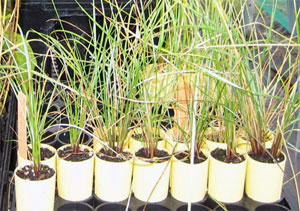In the North Bay, a new nursery is lending Mother Nature a hand.
 On a recent foggy morning, I drove up to the San Pablo Bay National Wildlife Refuge to tour their native plant nursery with biologist Giselle Block and nursery manager Leia Giambastiani. The Refuge hugs the northern reaches of the Bay (If you've driven across Highway 37, you've seen some of it). Historically this was part of one of the most extensive wetland systems on the West Coast. Here at the Bay's ecologically rich fringes, habitats shaded one to the next, from open water, to mudflat, to tidal marsh, to upland. During extreme high tides, marsh inhabitants like salt marsh harvest mouse and California clapper rail--both now endangered--sought refuge in the marsh-upland transition zone, where native plants provided cover from predation.
On a recent foggy morning, I drove up to the San Pablo Bay National Wildlife Refuge to tour their native plant nursery with biologist Giselle Block and nursery manager Leia Giambastiani. The Refuge hugs the northern reaches of the Bay (If you've driven across Highway 37, you've seen some of it). Historically this was part of one of the most extensive wetland systems on the West Coast. Here at the Bay's ecologically rich fringes, habitats shaded one to the next, from open water, to mudflat, to tidal marsh, to upland. During extreme high tides, marsh inhabitants like salt marsh harvest mouse and California clapper rail--both now endangered--sought refuge in the marsh-upland transition zone, where native plants provided cover from predation.
Over the past 150 years, the marsh-upland transition zone has, so to speak, gone the way of the wetlands. Now, with plans to restore 100,000 acres of the Bay's lost wetlands in the coming decades, scientists also are turning their attention to the critical habitat just above tide line. These days, as a result of our radical re-engineering of the Bay landscape, the transition zone is often on man made levees.
Once reconnected to the Bay, tidal marshes can do a lot of the work of restoring themselves, as seeds and nutrients travel in on the tides. But the transition zone is not so lucky. Without sources nearby, many seeds don't have a way to get there. Even if they manage the journey, native plants face stiff competition on levees from weedy invaders. Here's where the Refuge's nursery comes in, raising from seed native plants such as yarrow (Achillea millefolium), blue wildrye (Elymus glaucus), seaside woolly sunflower (Eriophyllum staechadifolium), and western goldenrod (Euthamia occidentalis), then marshaling volunteers to help remove invasives and plant the natives. In 2007--just its second year--the nursery propagated over 4,000 plants.
What makes this restoration work particularly exciting is that it is truly science in action, an ongoing experiment still working to answer a variety of questions: what's the best way to get rid of invasives? (Different projects around the Bay have experimented with using a plastic sheeting to "cook" the weed seeds--solarization--and using concentrated salt water from salt ponds to poison them--salinization). Which native plants fare best on the levees, a relatively harsh environment with soils that may differ from natural transition zones? Should the new plantings be left to do their thing, or do survival rates significantly improve with mulching or fertilizer?
